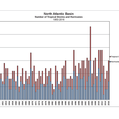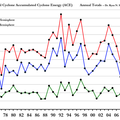LINK The Northern Hemisphere Just Experienced Its First-Ever Category 5 Cyclone in February
Story from end of Feb 2019. As predicted by global warming and climate change, more intense storms and new events. A Cat 5 hurricane in the Northern Hemisphere in February is a new unheard of event. Although blamed somewhat on El Niño, this event has been probably created by the reforming of the polar vortex after being shattered by hot air mass incursions in the North pole which disrupted the jet stream during this past winter but now returning to normal and sucking heat from the record hot summer of the Southern hemisphere
We’ve seen a lot of weird-ass tropical cyclones in recent years. This week, we can add another one to the list.
Typhoon Wutip formed and brushed Guam late last week. That alone made it an oddity in terms of timing and location. But rather than weakening as forecast, the storm blew up into a Category 5 monster over the weekend. That makes Wutip the first Category 5 storm of any kind—typhoon, cyclone, or hurricane—ever recorded in the Northern Hemisphere in February.
When we covered Wutip on Friday, all forecasts pointed to the storm wimping out over the weekend. Instead, the storm exploded into a super typhoon, a storm with winds in excess of 150 mph, on Saturday into early Sunday morning. Its sustained winds leaped from from 125 mph to 160 mph in just 12 hours with gusts reaching up to 180 mph, according to the Joint Typhoon Warning Center. That put it well above the previous February record holder, Super Typhoon Higos, which saw winds top out at 150 mph winds in February 2015. It also made Wutip the first February Category 5-equivalent storm to form not just in the Pacific but anywhere in the northern hemisphere.
Wutip also looked the part, with satellite imagery straight out of central casting. The storm had a wide and symmetrical eye at its peak. Both are characteristics of an annular cyclone, storms that tend to be exceptionally strong and usually form over open water.
The storm has since weakened as it chugs toward the Philippines, but what caused the power up seems to have been a bit of meteorological luck. The normal recipe for rapid intensification is weak upper level winds and ocean waters warmer than 30 degrees Celsius (86 degrees Fahrenheit). Those conditions are rare in the northern hemisphere in February, though El Niño—which is currently in effect—does tilt the odds towards them slightly in parts of the Pacific. In the case of Wutip, upper level winds were moderate and sea surface temperatures were around 29 degrees Celsius (84.2 degrees Fahrenheit), which was slightly warmer than normal.
Not prohibitive for rapid intensification, but also not a slam dunk. It appears Wutip simply beat the odds.



Enjoy being online again!
Welcome to the community of good people who base their values on evidence and appreciate civil discourse - the social network you will enjoy.Create your free account
4 comments
Feel free to reply to any comment by clicking the "Reply" button.Perhaps a more accurate statement would be, First ever recording of a category 5.
Given the age of Earth, the primative nature of mans ability to measure and record these phenomenon, and the amount of time humans have been measuring.
Id say there is no way to know this statement to be true. Its most likely a hyperbolic statement co-opted by climate alarmists to put into a headline for click bait.
Ah yes, another climate change denier. Sad!
SCal:
I don't deny climate changes.
Another ad hominem attacker with no take.
Sadder!
@BryanLV I accept this statement of yours : Perhaps a more accurate statement would be, First ever recording of a category 5... whithout omitting the in February and in the Northern Hemisphere part.
About this this statement: I don't deny climate changes
do you mean in general and over millions of years or Man made climate change?
SCal:
"do you mean in general and over millions of years or Man made climate change?"
I accept the data that shows that climate changes as a result of human behavior. But that is not what this article is about.
Also, a scientific concensus of any sort is not the equivalent of accuracy or truth.
@BryanLV Thanks for clarifying that I accept the data that shows that climate changes as a result of human behavior.
You will not engage me with your other irrelevant comments above. Thanks.
@BryanLV & @Lukian
Oh, to have been there with a wingsuit!!!!!
@BryanLV flattery will get you nowhere. X
Fascinating post. Let's see how many climate change deniers attempt to sound intelligent and post their uneducated opinions. Lol
SCal:
Youre winning the unintelligent post contest at the moment.
Perhaps you could try educating people, or a discussion? It seems your go to move is to name call and attempt to shame.
Rather weak and childish.
Apparently those scientists never heard of the Cincinnati Cyclones!
This site has been logging the number of cyclones per year and the accumulated energy of the cyclones. There had been no noticeable increase in cyclone activity since 1970:
fair point but the data gets muddled when factoring in tropical storms which is left out of the data you are referencing (which are creating just as much damages if not not more that Hurricanes it appears).
Ref: [ncdc.noaa.gov]
I accept your data. Do you accept mine?
BD66:
@Lukian Look at the reference and search for
"Global Tropical Cyclone Frequency"
There is absolutely zero trend that it is increasing.
The NOAA site you reference has picked two tiny portions of the earth where the number of hurricanes and/or tropical storms appears to be increasing.
You are then extrapolating what's going on in two tiny portions of the earth to reach the wrong conclusion that it's a worldwide trend.
You don't buy the religious propaganda.
Stop falling for the NOAA propaganda.
@BD66 ah well, your reference does highlight (as many other references) an over all cycle of lows and highs in hurricanes over several years across the century. Time will tell what the next high will bring us (I'll bet it's going to be higher, again).
This is just one factor in the global changes we are (and will be) experiencing with increasing atmospheric carbon. Only recently have we started detecting methane in the atmosphere which is compounding the problem.
Alarm bells are merited, yes.
Living in a prosperous and developed country, you probably won't get to suffer too much about the consequences in your lifetime, but your kids will and their kids.
Just go ahead and tell them everything is fine.
As for your last comment, as individuals, our tools and resources to limit and decrease global carbon are limited. Government policies/stewardship and industry leadership/innovation are the only way to make it happen. You and I are pawns in this game as usual.
BD66:
@Lukian "Government policies/stewardship and industry leadership/innovation are the only way to make it happen." If you look at where the increased consumption of CO2 is coming from, it's from the 1.386 billion in China and the 1.339 billion in India who want to lead the high energy consumption lifestyles of us here in the USA. Their consumption of coal is sky rocketing while ours is flat. Greenpeace was in India trying to get them to stop burning so much coal, and India kicked Greenpeace out of the country. Whatever self-inflicted punishment the US politicians inflict on the US people, it's an exercise in futility.
@BD66 I did not make the argument about this being a US only thing, did I? Last I checked, China and India have governments and Industry. Also, the last I checked, until 2020, every country in the world has signed the Paris Accord (or are intending to sign on i.e. Syria and Nicaragua) which indicate Stewardship in my book.
(also, are you buying into the carbon, fossil fuel conspiracy now?)
@BD66 you're not teaching me anything here. Coal is not the only fossil fuel.
Seems that Russia, India, USA and China (and another one called the Rest of World) have a big piece of the pie and a lot of work to do.
Unless you can do it yourself, how can countries be pressured to reduce their Carbon footprint? Peer pressure (via accords) from other governments as well as industry innovation.
ref:[ucsusa.org]
BD66:
@Lukian "Unless you can do it yourself, how can countries be pressured to reduce their Carbon footprint?" They can't. If we force people into the USA to use more expensive sources of energy, our industries will become less competitive, and we will lose jobs. Economic growth will slow, and people will be forced to use their lower incomes to buy more expensive energy. Other countries will go forward using the cheapest forms of energy available. All we will be doing is inflicting suffering on ourselves.
@BD66 great you're all for renewables then?
[sciencealert.com]
there are more jobs in renewables than in fossil fuels.
[eesi.org]
I like you more and more... we think alike.
BD66:
@Lukian When renewable forms of energy become more cost-effective than fossil fuels, energy companies will switch over and use renewables. It will happen just like magic, the way we shifted from paraffin candles to whale oil to kerosene to electric lights without government intervention. There's no reason to waste government money or punish American consumers in the meantime.
@BD66 oh looky here! Fresh off the press... Government Stewardship in action:
[arstechnica.com]
Enjoy being online again!
Welcome to the community of good people who base their values on evidence and appreciate civil discourse - the social network you will enjoy.Create your free account
Share this post
Related Groups More
Feline Fanatics
1538 members
Categories
Agnostic does not evaluate or guarantee the accuracy of any content. Read full disclaimer.










